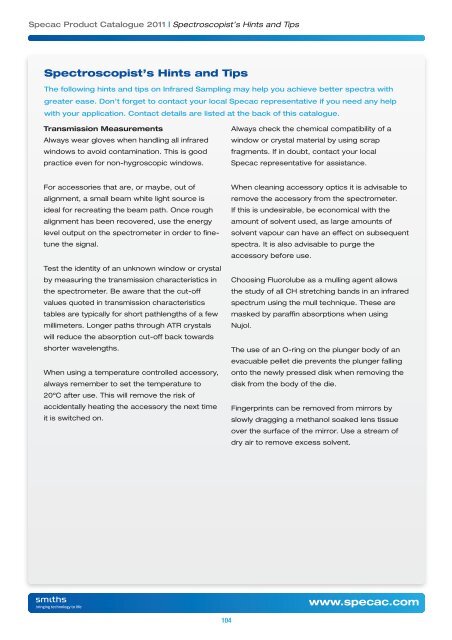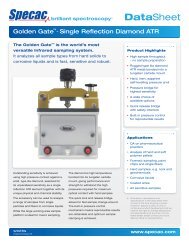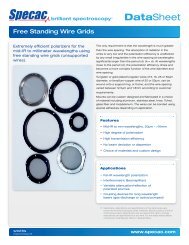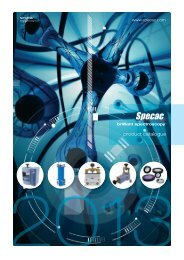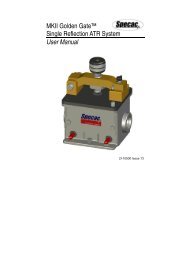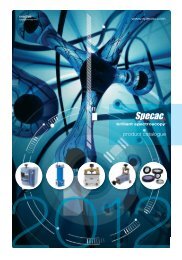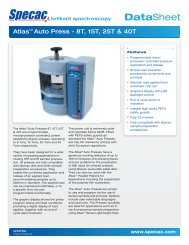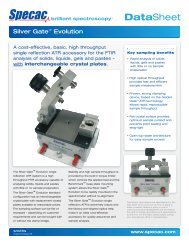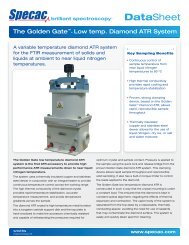2011 Product Catalogue - Specac
2011 Product Catalogue - Specac
2011 Product Catalogue - Specac
- TAGS
- product
- catalogue
- specac
- specac.com
Create successful ePaper yourself
Turn your PDF publications into a flip-book with our unique Google optimized e-Paper software.
<strong>Specac</strong> <strong>Product</strong> <strong>Catalogue</strong> <strong>2011</strong> | Spectroscopist’s Hints and Tips<br />
Spectroscopist’s Hints and Tips<br />
The following hints and tips on Infrared Sampling may help you achieve better spectra with<br />
greater ease. Don’t forget to contact your local <strong>Specac</strong> representative if you need any help<br />
with your application. Contact details are listed at the back of this catalogue.<br />
Transmission Measurements<br />
Always wear gloves when handling all infrared<br />
windows to avoid contamination. This is good<br />
practice even for non-hygroscopic windows.<br />
For accessories that are, or maybe, out of<br />
alignment, a small beam white light source is<br />
ideal for recreating the beam path. Once rough<br />
alignment has been recovered, use the energy<br />
level output on the spectrometer in order to finetune<br />
the signal.<br />
Test the identity of an unknown window or crystal<br />
by measuring the transmission characteristics in<br />
the spectrometer. Be aware that the cut-off<br />
values quoted in transmission characteristics<br />
tables are typically for short pathlengths of a few<br />
millimeters. Longer paths through ATR crystals<br />
will reduce the absorption cut-off back towards<br />
shorter wavelengths.<br />
When using a temperature controlled accessory,<br />
always remember to set the temperature to<br />
20ºC after use. This will remove the risk of<br />
accidentally heating the accessory the next time<br />
it is switched on.<br />
104<br />
Always check the chemical compatibility of a<br />
window or crystal material by using scrap<br />
fragments. If in doubt, contact your local<br />
<strong>Specac</strong> representative for assistance.<br />
When cleaning accessory optics it is advisable to<br />
remove the accessory from the spectrometer.<br />
If this is undesirable, be economical with the<br />
amount of solvent used, as large amounts of<br />
solvent vapour can have an effect on subsequent<br />
spectra. It is also advisable to purge the<br />
accessory before use.<br />
Choosing Fluorolube as a mulling agent allows<br />
the study of all CH stretching bands in an infrared<br />
spectrum using the mull technique. These are<br />
masked by paraffin absorptions when using<br />
Nujol.<br />
The use of an O-ring on the plunger body of an<br />
evacuable pellet die prevents the plunger falling<br />
onto the newly pressed disk when removing the<br />
disk from the body of the die.<br />
Fingerprints can be removed from mirrors by<br />
slowly dragging a methanol soaked lens tissue<br />
over the surface of the mirror. Use a stream of<br />
dry air to remove excess solvent.<br />
www.specac.com


